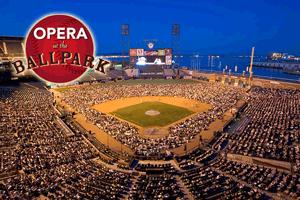
This Friday will mark the fifth time that the San Francisco Opera simulcasts its performance to AT&T Park, home of the San Francisco Giants baseball team. The SF Opera’s rendition of Aida will be free for all attending, yet the company reports that they hope to make money off the event. How? By gathering information. Those who wish to get into the ballpark early have to register and provide contact information. According to the Wall Street Journal, the SF Opera has been able to track new ticket sales generated by the simulcasts and found them to be around $880k in total, which more than covers costs ($800k). Yet economics aside, the SF Opera success at the ballpark has fascinated me for completely different reasons. It’s a great example of how technology can affect even very traditional art forms. Also, in a society that increasingly wants its entertainment on-demand and in the comfort of their homes, the choice to watch opera in a baseball stadium stands out. Are people simply enticed by the free product and the novelty, or is there something about watching classic art with a crowd that simply refuses to die?
I don’t just write for the internet, I’m also a member. I spend a lot my time online and I get the majority of my content from net sources. As I mentioned during the discussion about Google TV, I’m pretty sure that the majority of media, including television, will and should move online. You can find many wonderful opera performances on the internet, and DVD sales should let you see the performances upclose and personal in ways that you would never experience in a real opera house unless you paid hundreds of dollars.
So why is sitting in an arena hundreds of feet from a screen popular? Obviously people want to attend this event, the SF Opera is expecting 30,000 for the Friday simulcast, up from 25,000 last year. This free performance accounts for a good portion of their yearly attendance (300,000 for the 2008-2009 season). In fact, the performance is certainly increasing attendance in general – the 2007-2008 season saw 240,000 in the opera house. These are expensive seats (many over $100) during a recession. The opera at the ballpark (a free event) is pulling a significant number of people into paying for the real thing. I’m not surprised by the fact that a free performance brings in regular attendees (that’s a bet many theaters have been making for years), it’s just that I don’t think of the ballpark experience as being all that seductive. Watch the brief video below to see a clip of someone’s experience at a SF Opera Simulcast to see what I mean:
I don’t think that the sound, the video, or the temperature is going to be as nice at AT&T park as it would be at the opera house, yet this experience is still drawing people in. Is it just the magic of the opera? Maybe. But I think it also has to do with the magic of a crowd, and the opportunities provided by modern technology.
There’s a certain excitement that comes from watching an event you know is live, and that excitement is amplified by being shared with people around you. The “anything could happen” mindset lends an edge, and increases the feelings of importance, to a performance. Modern fiber optic cable and video equipment allow the SF Opera to be in two places at once, so that viewers at the ballpark can watch something they know is alive and happening not too far from where they sit. Not only that, but they do so in an environment that is public, friendly, and inviting. You never know what could happen. Exhibit A, taken from another SF Opera Simulcast:
Ok sure, so there’s something very enticing about watching a live theatre event with a crowd. You already knew that, though. Here’s how the Opera at the Ballpark is unique: that ‘crowd’ isn’t just a few hundred people as you would experience with a play, or a classic performance of an opera, it’s 30,000 adults and children in an arena. That’s a much bigger and more powerful group to interact with. It’s the kind of energy you get from a sports event, only with fewer chest bumps.
It’s probably no wonder then, that this kind of simulcast is having success with Opera, which is probably the most showy, dramatic, and arena-friendly of classical art forms. Bringing in crowds of tens of thousands makes sense when you have performers belting out five minute solos about love, death, and war. It’s a rock concert with subtitles and better costumes.
And it may be a sign that we aren’t ready to crawl inside our computers and shut out the physical world. Until the internet can provide us the visceral energy of sharing a a crowd of thousands, there’s going to be a need for arena performances. Entities like the SF Opera are wise to leverage modern technology to take advantage of that need and use it to re-imagine their art forms. It will be interesting to see if other art forms follow the trend, and I’m curious to see if other opera houses can replicate San Francisco’s success. The Washington National Opera is already trying it out. Who knows, stadiums may be the way theater, opera, symphony, and other classic art forms save themselves from an early death.
[image credit: MLB]
[source: SF Opera, Wall Street Journal]


